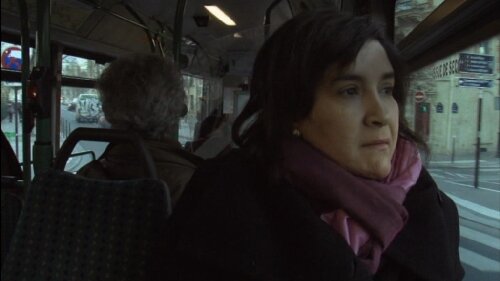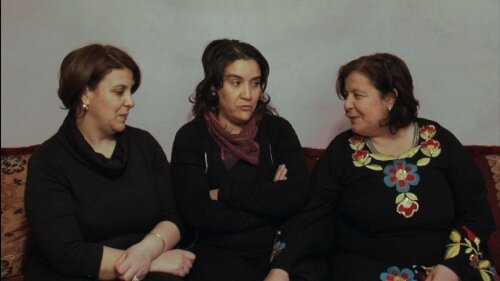
Penny Allen made her first feature film,
Property (1977), in Portland’s Lair Hill neighborhood on a CETA grant. She made her third feature film, En retard pour l’enterrement de ma mère (
Late For My Mother’s Funeral) in Algeria, with French financing, a French crew, and a French speaking cast of non-professional Morrocan-Algerian-French actors.
.
The godmother of Portland independent filmmaking recently sat down to an email interview with Oregon Movies, A to Z.
.
Anne: You’ve made narrative films (Property, Paydirt) and a documentary (The Soldier’s Tale). Late For My Mother’s Funeral blurs narrative and documentary. How did this happen? Did the mixing begin to happen as you made the film, or was that present from the first moment of conception?
.
Penny: When it played at the Museum of Modern Art in New York, Property was described as a film that appears to be a documentary but as it continues, the spectator realizes it is constructed and fully fictional. My third film The Soldier’s Tale has an essentially fictional segment which ends the film even though the beginning and middle parts are documentary. So the blurring of narrative fiction and documentary in Late for My Mother’s Funeral is a continuation, or further development, of my preference for mixing the two forms. This hybrid genre is the genre I feel comfortable in.
.
.
The principal reason for working this way is that, for me, the mix corresponds to reality, which itself operates in a range from total fiction (imagination, or falsehood, or misrepresentation, or manipulation) to total documentary (such as what one might see on a hidden camera where nothing happens for hours). In the case of Late for My Mother’s Funeral, the two major characters were given the opportunity to speak directly to the camera for the change of perspective this offers to the spectator. To sort of tell you what is happening. This kind of scene is not really documentary or fiction but something else altogether. There is also an extract of a movie within my movie. I tend to use whatever I think works and try to make it seamless.
.
Anne: What drew you to this story?
.
Penny: I have lived in France for 22 years now, a country with a population that is 12% Muslim, the majority of which is Maghrebin (Algerian and Moroccan primarily). Algeria was part of France for 130 years, and the Algerian culture is very present in France today. There are probably as many variations on Algerian immigration as there are immigrants, of many generations by now, ranging from the happiest, most successful at expressing themselves, to the most oppressed and miserable. By luck, I have lived in neighborhoods — the 20th, the 14th, the 3rd, and now the 18th arrondissements of Paris — with large Maghrebin populations. My interest in their culture, history, and politics has been stoked for years. All this to say that it was natural for me to eventually think in terms of a story.
.
In the case of the particular story of Late for My Mother’s Funeral, the main character Abdeljalil came to a screening in Paris of The Soldier’s Tale and came up to me afterwards to ask me to make a movie about his story. So I was invited in.
.
.
Anne: Were you already familiar with Arabic culture, and Arabic family structure, before you made this film, or if it was a discovery process for you, as you were making the film. To me, the film felt deeply anthropological, even though you were directing actors, and using the mother’s dress as a unifying motif.
.
Penny: An Algerian critic in Paris wrote that he thought the film was the most intimate portrait of Algerian culture he’d ever seen. If this is so, it’s thanks to the Zouhri family. The film is deeply anthropological, and the Zouhri family is the subject. The idea that came from outside the culture, from me, was that one of the sisters could wear the mother’s dress and play the mother. This is not part of their culture, but I thought doing this would get us started, and it did.
.
Anne: You said you spent three years making this film. What was that like?!
.
Penny: We filmed over the course of almost 3 years, about 9 weeks altogether, in order to follow the story as it evolved. We also edited and re-edited over the course of a year after that, making it almost 4 years.
.
I had been meeting in Paris with Abdeljalil Zouhri, the main character in the movie, about twice a month for at least a year, but without the intention of doing a movie. He wanted to talk about the relations and history between Algeria and Morocco. I listened, asked questions, filled a couple of notebooks. He also inspired me to read several books, including “The Harem and the Cousins,” by anthropologist Germaine Tillion.
.
.
Then, when Abdeljalil’s mother died, and when I learned what a personality she had been, a gold and jewel smuggler raising 10 children alone, and when Abdeljalil revealed his own existential crisis in a very touching way, I wanted to do a movie. That was what he had been wanting all along, but it took an acute situation to get me started writing.
.
We went very soon to Macon, in Burgundy, where I met 6 of Abdeljalil’s sisters and brothers, most of whom he had not seen for years. They had been estranged. Soon after that, with Abdeljalil, a cameraman and a soundman, we left for Algeria for the first shoot. It was still not long after the death of the mother. The family’s mourning in the film is very new, very intense, very raw. It was in Algeria that for the first time I met Samira and Souaad, both of whom became important in the filming, particularly Souaad, whose own story later hi-jacked the movie, even though her story is of course related to the mother’s death and to the fact that her mother had been the center of her family’s universe during a turbulent period of history.
.
.
It was important for me to be patient and to listen and learn a great deal, to follow clues that were offered, and to offer ideas of my own that corresponded to what was happening. It would never have been possible to start the movie any later after the mother’s death, because mourning does end usually, and conflicts forgotten during mourning once again rose to the surface. Now, for example, Abdeljalil has broken off contact with family members in Macon, as he had done before his mother’s death. I am still very much in contact with Abdeljalil and with Souaad, less so with the others, although I was invited to a family wedding recently, about 5 years after the mother’s death, and everyone treated me like a member of the family.
.

.
Anne: The importance of the house in the narrative, and the almost claustrophobic focus on interpersonal relationships…. I felt I saw some similarities with Property. In both films, there is the sense that an embattled community has walled out the world. What do you make of these parallels?
.
Penny: In Algeria, the enormous family villa and hammam in the film is the space where now, without the queen, if all ten brothers and sisters were there together, it would be a miracle. When the mother reigned there, it was full of life and meaning. What the villa means now or in the future is part of what steers events in the film. The villa was also a fabulous and inspiring decor in which to shoot, with endless possibilities. And people came to the villa, so there was a constant flow of people inside or on the roof. This lead to an intensity of interactions. That is the way social life occurs in small-town western Algeria in general — inside or on the roof. Especially when there were all those sisters. And in a dynamic family, a lot happens when people come calling. Visitors are welcome. There is a lot of palavering and activity, especially on the roof.
.
Property shares one important thing with Late for My Mother’s Funeral, and that is having 8 main characters. I have often been interested in group interactions. In Property it seemed the characters really liked their community, but they had drifted there without the intent to wall themselves off. They were content to stay put. Property was more of a “chamber movie,” as critic Amos Vogel called it.
.
Anne: Thank you, Penny!
.
http://www.pennyallenfilm.com/HomeEN.html
.
http://www.vimeo.com/78632481

1 response so far ↓
1 bob williams // Dec 20, 2013 at 2:29 pm
If Penny were a quarter as gifted in self promotion as she is in her arts, they’d have named streets for her on both sides of the Atlantic!
Instead she spends the time that doesn’t go to that actually listening hard to our answers to her great questions.
Bravo, Penny. You always show up and nothing seems to retard your constant progress.
Leave a Comment